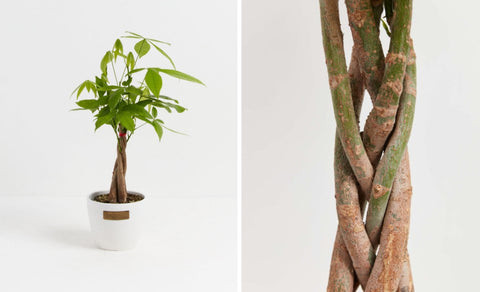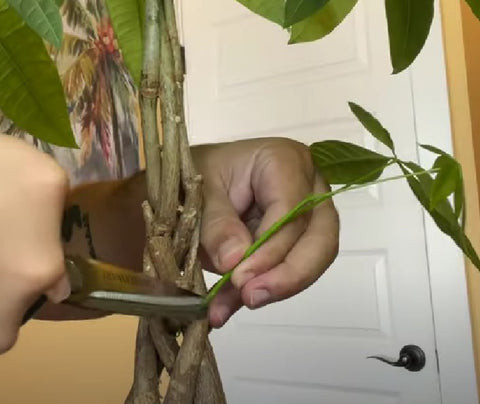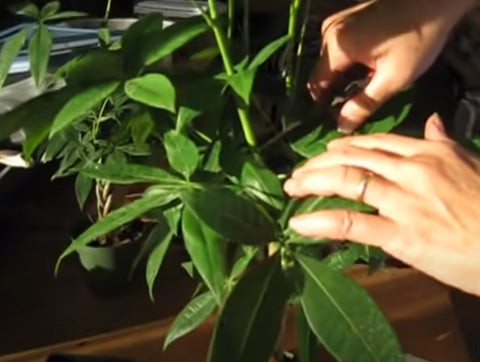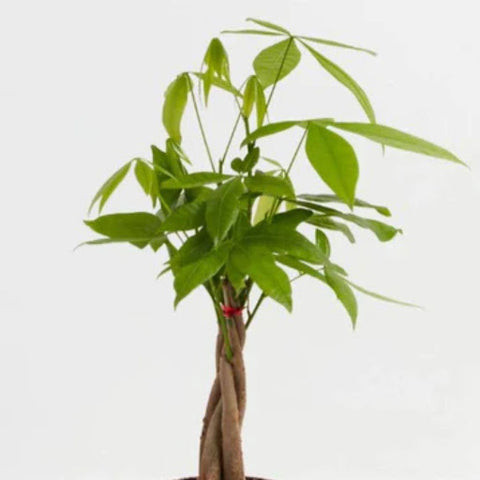The Money Tree, or Pachira Aquatica, is a popular houseplant celebrated for its braided trunk and vibrant green foliage. Native to Central and South American wetlands, this plant adapts well to indoor environments. However, its vigorous growth can sometimes become unruly, making pruning a necessary part of its care. Pruning your Money Tree isn’t just about aesthetics; it’s crucial for the plant’s health and vitality.
This guide will walk you through everything you need to know about how to effectively trim your Money Tree. We’ll cover why pruning is beneficial, when the best time to prune is, the right tools for the job, and step-by-step instructions to ensure your Pachira Aquatica thrives.
Why Prune Your Money Tree?
 About Money Tree Plants
About Money Tree Plants
Pruning a Money Tree offers several key advantages that contribute to the plant’s overall health and appearance:
- Encourages Healthy Growth: Removing dead or dying branches and leaves allows your Money Tree to focus its energy on new, healthy growth. This redirection of resources is vital for maintaining the plant’s vigor.
- Disease Prevention: Pruning is an effective way to manage and prevent the spread of plant diseases, such as fungal or bacterial infections. By removing affected parts, you can protect the rest of the plant.
- Shape and Bushiness: Regular trimming encourages bushier growth, especially at the top of the plant. If your Money Tree is becoming leggy or sparse, pruning can promote a fuller, more appealing shape.
- Improved Air Circulation and Light Exposure: Overly dense growth can restrict airflow and block sunlight from reaching the inner parts of the plant. Pruning helps to thin out the foliage, improving air circulation and light penetration, which are essential for photosynthesis and preventing weak growth.
When is the Best Time to Trim a Money Tree?
 When to Prune Money Tree
When to Prune Money Tree
The ideal time for pruning your Money Tree is during the spring or summer months. This is when the plant is in its active growth phase, allowing it to recover quickly and put out new shoots. Pruning during the growing season minimizes stress and maximizes the benefits of trimming.
However, it’s also acceptable to prune your Money Tree at other times of the year if you need to remove damaged or dead branches as they appear. Addressing these issues promptly, regardless of the season, is important for plant health.
Essential Tools for Pruning
Before you start pruning, gather these simple tools:
- Gardening Gloves: Protect your hands from any potential irritants and ensure a good grip.
- Pruning Shears or Scissors: Use sharp, clean pruning shears or scissors for making precise cuts.
- Rubbing Alcohol: Sterilize your pruning tools before and after use to prevent the spread of diseases.
- Clean Cloth or Small Brush: Useful for wiping away any dirt or debris from the leaves for better visibility during pruning.
Sterilizing your tools is a crucial step to prevent introducing bacteria or fungi to your Money Tree through pruning cuts.
Step-by-Step Guide: How to Trim Your Money Tree
 How to Prune a Money Tree
How to Prune a Money Tree
Pruning a Money Tree involves understanding the specific issues you want to address. Here’s how to approach different pruning scenarios:
Trimming Damaged Leaves
Start by inspecting your Money Tree for any dead, damaged, or diseased leaves. These are often yellow or brown and can detract from the plant’s appearance and health.
- Identify Damaged Leaves: Locate any leaves that are discolored, spotted, or clearly unhealthy.
- Make Clean Cuts: Using your sterilized scissors or pruning shears, cut the leaf stem close to the main branch or trunk. Remove the entire leaf stem to prevent any potential disease spread and encourage clean growth.
- Dispose of Removed Leaves: Discard the damaged leaves properly to avoid any disease from spreading to other plants.
Pruning Overgrown Money Trees
If your Money Tree has grown too tall and leggy, pruning the top can encourage growth lower down, creating a fuller shape.
- Determine Desired Height: Decide how much you want to reduce the height of your Money Tree.
- Locate Leaf Nodes: Identify a leaf node (the point where a leaf grows from the stem) just below your desired cutting point.
- Cut Above Leaf Node: Make a clean cut just above a leaf node on the main stem. Cutting above a node encourages new growth from that point, leading to bushier growth.
- Repeat as Necessary: You can repeat this process for other overly tall stems to achieve a more balanced height.
Thinning Dense Growth
Money Trees can become very dense, which can restrict light and air circulation. Thinning out the plant helps maintain a healthier environment.
- Identify Overcrowded Areas: Look for areas where branches are growing too closely together, especially towards the center of the plant.
- Select Inner Stems for Removal: Choose stems from the interior of the plant to remove. Focus on stems that are crossing or rubbing against each other, or those that are growing inwards.
- Cut Back to Main Stem: Cut these inner stems back to their point of origin on a larger branch or the main trunk. This opens up the plant’s canopy, improving airflow and light penetration.
Reshaping for Aesthetics
To maintain the Money Tree’s natural tree-like shape, you may need to prune branches that grow out of proportion.
- Assess the Shape: Step back and look at your Money Tree’s overall shape. Identify branches that disrupt the desired tree-like form.
- Trim Extending Branches: Cut back any branches that extend too far outwards or create an uneven silhouette.
- Angle Cuts for Natural Look: Make cuts at a slight angle, just above a leaf node that is facing in the direction you want new growth to occur (usually outwards or upwards).
Reviving Bare Branches
If your Money Tree has long, bare branches with few leaves, pruning can stimulate new growth and improve its appearance.
- Identify Bare Branches: Locate branches that are long and sparsely leaved.
- Cut Back Above Leaf Node: Prune these branches back to a point just above a leaf node. This encourages the plant to send out new shoots from the node, resulting in a fuller branch.
- Monitor for New Growth: After pruning, monitor these branches for new growth. It may take a few weeks, but you should start to see new shoots emerging.
Where to Make the Cut: The Leaf Node
Regardless of the pruning scenario, always aim to cut just above a leaf node. The leaf node is where new growth originates. Cutting in this location stimulates the plant to sprout new branches and leaves from that point, promoting healthy and directed growth. Aim for about ⅓ inch (1.3 cm) above the node for best results.
Post-Pruning Care for Your Money Tree
 Money Tree Care Post Pruning
Money Tree Care Post Pruning
Pruning can be a bit stressful for your Money Tree, so providing proper aftercare is essential for its recovery and new growth:
- Light: Place your Money Tree in a location with bright, indirect sunlight. Aim for at least 6 hours of light per day. If natural light is insufficient, consider using grow lights.
- Watering: Allow the top inch of soil to dry out before watering. Adjust your watering schedule according to the season, watering more frequently in summer and less in winter.
- Soil and Repotting: Ensure your Money Tree is planted in a well-draining potting mix with a pH between 6.0 and 7.5. Repot your plant if it outgrows its current container, using a fresh, nutrient-rich peat-moss-based mix.
- Temperature and Humidity: Maintain a temperature range between 65°F and 75°F (18°C – 24°C). Avoid placing your Money Tree near heaters or cold drafts. Increase humidity by misting the leaves, using a pebble tray with water, or a humidifier.
- Fertilizing: Feed your Money Tree with a diluted liquid fertilizer every 2-3 months during the growing season. Avoid over-fertilizing, as this can harm the plant.
FAQs About Pruning Money Trees
Q: How do you encourage new growth on a Money Tree?
A: Encourage new growth by providing bright, indirect light, watering appropriately, fertilizing during the growing season, and pruning leggy or damaged branches.
Q: Should I remove dying leaves from my Money Tree?
A: Yes, promptly remove dying or yellowing leaves. This directs the plant’s energy to healthy growth. Use clean scissors to cut leaves at the base, being careful not to remove too many leaves at once.
Q: Can you cut the top off a Money Tree?
A: Yes, cutting the top off a Money Tree is an effective way to control its height and promote bushier growth. Make the cut just above a node to encourage new shoots.
Q: Where is the node on a Money Tree?
A: The node is a small bump or ring on the stem where leaves, stems, or branches originate. It’s typically found where a leaf or branch connects to the main stem.
Q: Where to cut a Money Tree for propagation?
A: For propagation, take cuttings just below a node on a healthy stem that is about 6 inches long and has at least 2-3 leaves. Remove lower leaves and root the cutting in water or moist soil.
Conclusion
Pruning your Money Tree is a straightforward yet essential practice for maintaining a healthy, vibrant, and aesthetically pleasing plant. By understanding when and how to trim your Pachira Aquatica, you can address issues like overgrown branches, damaged leaves, and promote bushier, healthier growth. Remember to use clean tools, make precise cuts above leaf nodes, and provide proper post-pruning care to ensure your Money Tree continues to thrive and bring prosperity to your space. Consider pairing your Money Tree with companion plants like Pothos, Spider Plants, or Peace Lilies for a lush and inviting indoor garden.